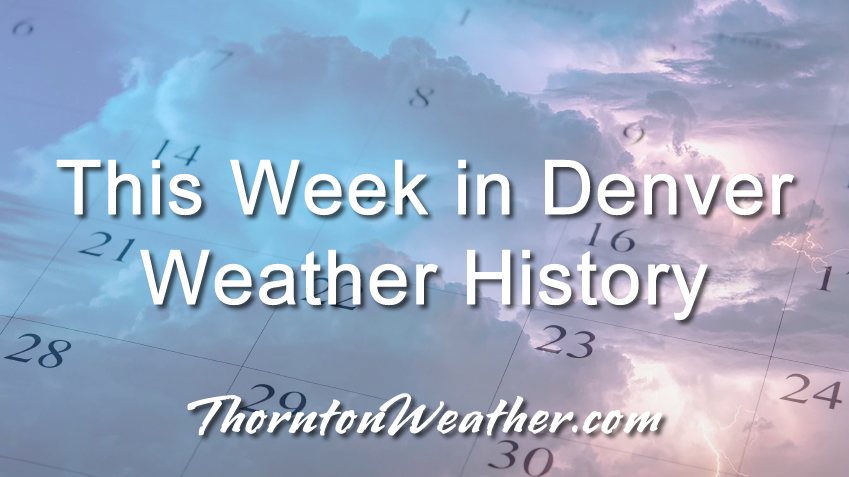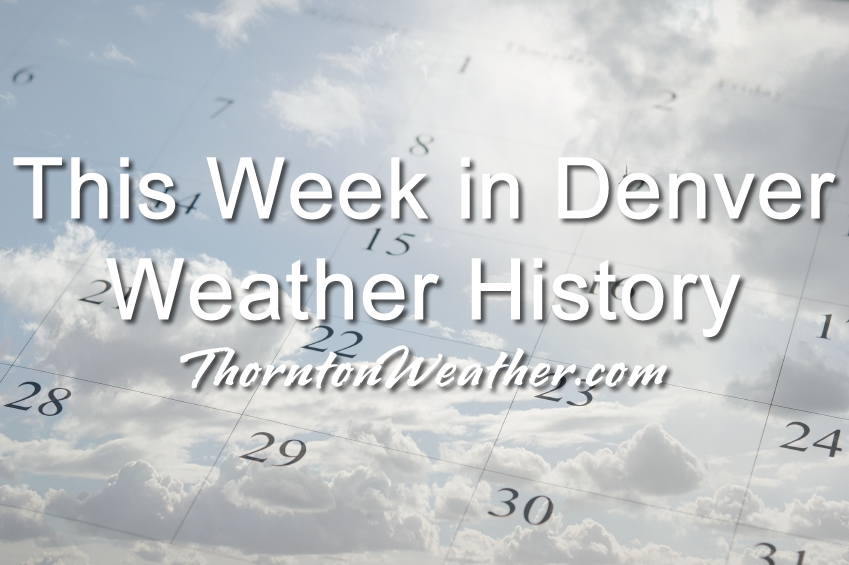The end of the year and beginning of the next can be an eventful period in terms of weather in the Denver metro area. Looking back at this week in Denver weather history there are certainly periods of cold and snow but perhaps most notable are the number of damaging wind events.
From the National Weather Service:
25-31
In 1980…temperatures were unusually warm during the week between Christmas and New Year’s. High temperatures for the week ranged from the mid-50’s to the mid-70’s. Four temperature records were set. Record highs occurred on the 26th with 68 degrees…the 27th with 75 degrees…and the 30th with 71 degrees. A record high minimum temperature of 41 degrees occurred on the 27th.
27-29
In 1983…a second surge of bitter cold air in less than a week was less intense. Record breaking low temperatures of 12 degrees below zero on the 28th and 15 degrees below zero on the 29th were accompanied by 3.7 inches of snowfall and northeast winds gusting to 23 mph.
28-29
In 1906…a trace of snow fell on both days…which along with a trace of snow on the 5th…was the only snow of the month…ranking the month the second least snowiest December on record.
In 1970…wind gusts to 87 mph were recorded at the National Center for Atmospheric Research in Boulder. Winds gusted to only 46 mph in downtown Boulder. Damage was minor.
In 2006…while metro Denver residents were still digging out from the heavy snowfall and blizzard that occurred on December 20-21…the second major winter storm in a week buried the city and the eastern foothills again in more deep snow. Heavy snowfall ranged from 1 to 2 1/2 feet in the foothills and from 6 to 18 inches across the city. Another slow moving storm system centered over the Texas panhandle produced deep upslope flow over the high plains and against the Front Range mountains. The storm produced blizzard conditions over the plains mainly south of Interstate 76. Interstate 70 as well as other roads and highways was closed from Denver to the Kansas line due to snow and blizzard conditions. Greyhound was forced to cancel all bus trips from Denver. The heaviest snow fell in and near the foothills and south of Denver over the palmer divide…where north winds sustained at speeds of 20 to 30 mph with gusts to 40 mph piled the snow into drifts 4 to 14 feet deep. In the city…the heavy snowfall persisted for a total of 29 hours. Snowfall totals across metro Denver included: 17.5 inches at Ken Caryl; 15 inches 3 miles south-southeast of Morrison; 14 inches in Boulder and lone tree; 12 inches in Castle Rock and Highlands Ranch; 11 inches in Wheat Ridge; 10.5 inches in Littleton; 10 inches in Arvada…Broomfield…and Louviers; and 8.5 inches in Lakewood and Thornton. Officially…snowfall totaled 8.0 inches at Denver Stapleton. North winds sustained to 25 mph with gusts to 32 mph produced some blowing snow at Denver International Airport. In the city…this second storm increased the total snowfall for the month to 29.4 inches…making the month the third snowiest on record. In the foothills the snow fell at a rate of 3 to 4 inches an hour at times. Total snowfall in the foothills included: 30 inches near Genesee; 29.5 inches 12 miles northwest of Golden; 25 inches in Evergreen and near Bergen Park; 24 inches near Conifer; 23.5 inches 3 miles southwest of Golden and near Gold Hill; 23 inches near Jamestown; 22.5 inches in Rollinsville; 19.5 inches in Aspen Springs; 19 inches near Blackhawk; 18.5 inches at Nederland; 16 inches in Indian Hills…at Intercanyon…and in Eldora; 15.5 inches at Echo Lake; and 12 inches near Ralston Reservoir. The total cost of snow removal just at Denver International Airport from this storm and the previous storm was in tens of millions of dollars. The airport estimated up to 6.7 million dollars in extra costs for contractors…overtime…equipment…de-icing chemicals…and other expenses. The two storms cost the airport 4.6 million dollars in loss concession revenues. United Airlines reported lost revenue of over 25 million dollars from the two storms…while Frontier Airlines lost an estimated 12.1 million dollars.
29
In 1997…high winds persisted mainly in and near the foothills. Strong cross winds gusting between 60 and 70 mph blew a rental truck off the roadway in northern Jefferson County near the Coal Creek Canyon road. West winds gusted to 33 mph at Denver International Airport.
In 2005…high winds were recorded across metro Denver. Peak wind gusts included 75 mph near Chatfield Reservoir and 64 mph at Denver International Airport. No damage was reported.
29-30
In 1898…heavy snowfall totaled 6.2 inches in downtown Denver. Northeast winds were sustained to 35 mph with gusts to 40 mph on the 29th.
In 1912…strong winds buffeted Boulder…causing hundreds of dollars damage. The winds were described as one of the most terrific in the history of the city.
In 1923…a cold wave caused temperatures to plunge 58 degrees in 24 hours. The temperature was 54 degrees at 2:00 pm on the 29th and only 4 degrees below zero at the same time on the 30th. The low temperature of 14 degrees on the 29th was the high temperature on the 30th. The low temperature on the 30th dipped to 10 degrees below zero. Light snowfall totaled only 0.7 inch. Northeast winds were sustained to 23 mph on the 29th.
In 2008…very strong Chinook winds blasted areas in and near the foothills of Boulder and Jefferson counties. The wind blew down trees and power poles…downed electrical lines and fences…and damaged homes and vehicles. Scattered power outages were reported along the Front Range. In metropolitan Denver alone…24000 Xcel customers were affected by the outages. Four planed were damaged at the Vance Brand Municipal Airport in Longmont…one was heavily damaged. Insurance companies estimated up to 7 million dollars in damage. Peak wind gusts included 87 mph at the national wind technology center…86 mph…2 miles north of Longmont; 77 mph at Erie…and 75 mph at Lafayette. On the 30th…a peak wind gust to 47 mph was recorded at Denver International Airport. .
30
In 1875…snow fell from the early morning into the early evening. While the amount of snowfall was not recorded… Precipitation from melted snow totaled 0.53 inch. Good sleighing was reported…so snowfall must have been 5 inches or more.
In 1895…northwest winds were sustained to 60 mph in the city.
In 1897…west winds sustained to 52 mph with gusts to 60 mph warmed the temperature to a high of 55 degrees.
In 1912…west winds were sustained to 48 mph with gusts to 52 mph. The Chinook winds warmed the temperature to a high of 50 degrees.
In 1928…snowfall was 0.1 inch in downtown Denver. This was the only measurable snow of the month…ranking the month the third least snowiest on record in the city.
In 1990…strong downslope winds buffeted the eastern foothills. Wind gusts to 91 mph were recorded atop Table Mesa in southwest Boulder…while a gust to 94 mph was clocked at Rollinsville. The high winds caused whiteout conditions due to blowing snow along some highways south and north of Boulder. The high winds downed power lines near the Rocky Flats plant south of Boulder.
In 1998…high winds continued to buffet areas in and near the foothills. Near Evergreen…a 100-foot-high blue spruce crashed down on the roof of a home…splitting the corrugated metal roof in half. Fortunately…the tree… Which measured 10 feet in circumference…only penetrated the home’s interior in a few places. Peak wind reports included: 90 mph at Wondervu…88 mph at the Rocky Flats test facility…83 mph near Conifer…and 82 mph atop Blue Mountain near Coal Creek Canyon. West winds gusted to 39 mph at Denver International Airport.
30-31
In 1886…heavy snow totaled 6.5 inches in downtown Denver. Most of the snow…4.5 inches…fell on the 31st. North winds were sustained to 18 mph.
In 1928…snowfall of 0.6 inch was the only measurable snow of the month in the city.
In 1947…post-frontal heavy snow totaled 6.3 inches over downtown Denver. Most of the snow fell on the 30th. North winds were sustained to 17 mph on the 30th.
In 1995…the foothills west of Denver received 5 to 9 inches of new snow…except for Bailey where 11 inches of snow were measured. No snow fell at the site of the former Stapleton International Airport.
31 Continue reading December 29 to January 4: This Week in Denver Weather History


